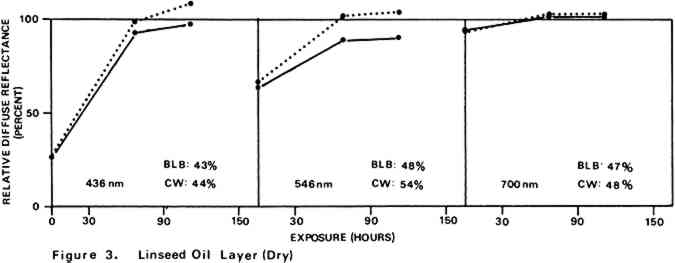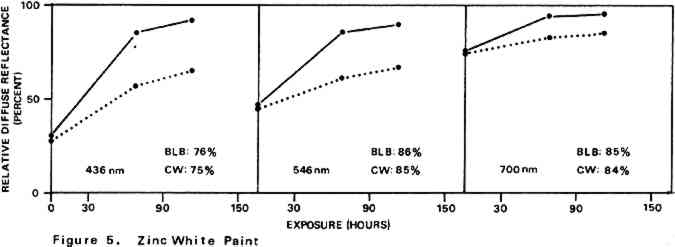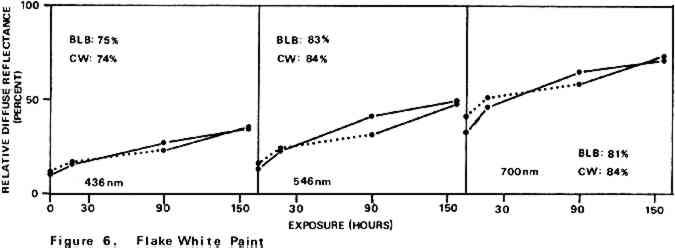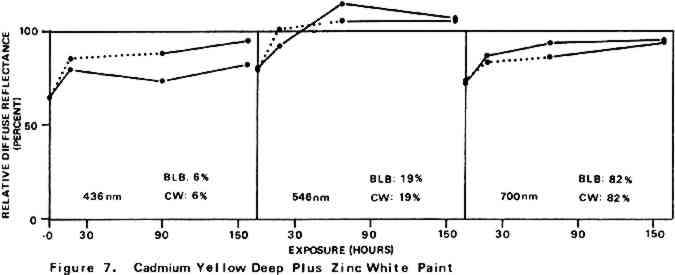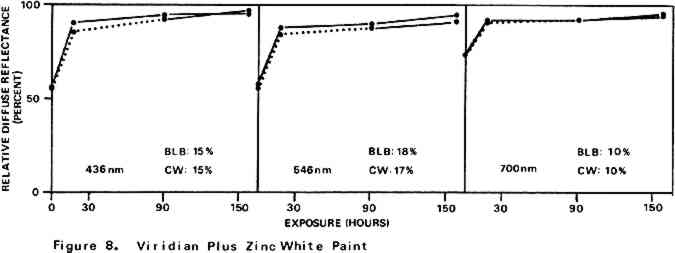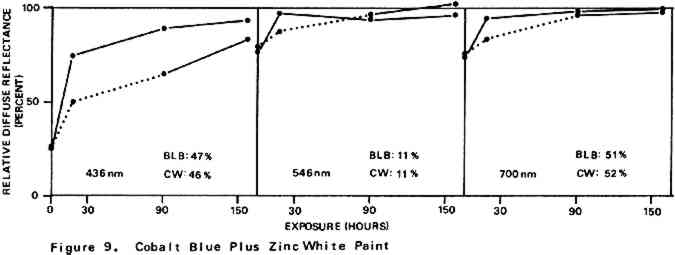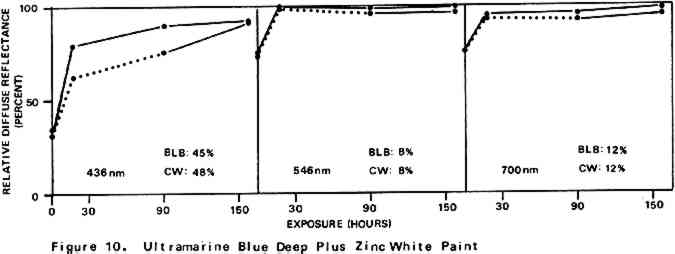THE RECOVERY OF COLOR IN SCORCHED OIL PAINT FILMSChristopher Tahk
2 DISCUSSION AND RESULTS2.1 Scorching Characteristics of the Paint SamplesTHE EXTENT to which a paint sample darkened in a scorch cycle, as measured in terms of relative diffuse reflectance at each wavelength, is given by the first point in each of the reflectance-light exposure plots (Figures 3–10). Considerable differences in degree of color change which occurred in the paints are apparent. The variation in extent of darkening which can take place is perhaps most strikingly illustrated by the three whites. Titanium white is appreciably darkened, zinc white yet more so, and flake white is the most discolored, its 435 nm and 546 nm reflectance values being reduced to less than 20% of their original magnitude.
For almost all of the paint samples the relative decrease in reflectance observed in the scorch cycle at the three selected wavelengths is generally consistent with yellowing of the medium as the principal source of total color change. Such yellowing, most apparent in the case of the pure linseed oil film (Figure 3), results in greatest reflectance loss at the blue end of the spectrum and least at the red (i.e., relative reflectance decreases are greatest at 435 nm and least at 700 nm). The fact that different paints discolor to different extents under identical scorch conditions does not prove the pigments play a significant role in producing discoloration. For example, the yellow paint cadmium yellow deep will not suffer much color change if its medium becomes yellow whereas blue paints such as ultramarine blue will be darkened owing to absorption by the yellow medium of the blue light responsible for the paint's color. Too, the relative transparency and oil-to-pigment ratio of a paint will determine the length of the light path through its medium and, therefore, the extent to which a given degree of yellowing will alter original paint color. However, the blistering of flake white which took place only during the scorching of this paint strongly implies possible pigment involvement in the process. The blisters could have been caused by bubbles produced by the reaction of organic acids, created in the medium by heat, with the lead pigment to produce carbon dioxide gas and water 2.2 Light Bleaching of the Scorched Paint2.2.1 A. Summary of experimental results.The reflectance-light exposure plots for the paint samples show that all are significantly bleached during the exposure period by radiation from either the visible or the ultraviolet light banks, some color recoveries being particularly striking. Note that for visible light bleaching a twenty-five hour exposure equals approximately one million lux hours. A painting will receive a million lux hour exposure when on exhibit in a properly illuminated museum for no more than a few years. If, as is likely the case, the extent of bleaching is determined by total light exposure and not its intensity, then keeping a heat-darkened painting on exhibit rather than in storage out of the light is one way of noticeably improving its colors. The reflectance-light exposure plots for most paints show that the visible light bank with its UF-3 Plexiglas filter gives off negligible ultraviolet radiation and is more powerful in its bleaching action than is the ultraviolet bank. This comparison does not take into account the fact that radiation from the latter is about only 40% as intense on an energy basis. If intensity of radiation alone, not wavelength, determines bleaching rate, a scorched paint film should bleach about 40% as rapidly under the ultraviolet bank as it would under the visible. For a few paints (cobalt blue plus zinc white, ultramarine blue plus zinc white, and zinc white alone), even on an equal energy intensity basis, visible light appears to be the superior bleach, at least over the bleaching periods within which most of the scorched paints underwent the greatest extent of color recovery (see Figures 3–10). For other paints, visible and ultraviolet radiations at equal energy intensities are either comparable in effecting color recovery or the ultraviolet radiation appears superior. Whether this relative effectiveness of the two light sources holds up over longer exposure times has not been established, although preliminary, qualitative experiments carried out by the author suggest that it does. A reason for preferring visible to ultraviolet light bleaching in all cases is considered later in this section in a discussion of bleaching chemistry. Figures 3–10 also show that, with the exception of flake white paint, the rate of color recovery decreases with exposure time. In separate experiments involving longer light exposure periods, however, flake white paint has also been found to exhibit this bleaching behavior. While the data are insufficient to permit a specific relationship to be established between total exposure and degree of color recovery, it is apparent that perfect color recovery, if attainable at all in most appreciably scorched paints, would require extremely long bleach times. Certainly, in any practical application of this method in conservation, a compromise must be struck between the extent of color recovery realized and the length of light exposure time necessary to obtain it. Most of the exposure-reflectance charts also show that bleachings tend to give recovery of a color close to the original rather than producing another distinctly different in appearance. There are a few exceptions: in these, the relative reflectance values at each of the three wavelengths measured do not always return to the 100% relative reflectance value as exposure times increase. In the instance of cadmium yellow deep, the high 546 nm values are not easily explained except by assuming that some slight change in pigment color has occurred. This is in accord with Levinson's comment17 that cadmium yellows “have limited reliability if subjected to too much A study of the possible enhancement of light bleaching by exposing darkened samples first to one light bank and then to the other was unrewarding. Scorched paint samples which had received a ninety-one hour exposure under the ultraviolet lamp bank were exposed for an additional sixty-seven hours under the visible bank (see Figures 6–10). The final visible light exposure somewhat increased the extent of 2.2.2 B. Chemical aspects of scorched paint bleaching.Even though the specific bleaching reactions are unknown, the initial steps are certainly photochemical. Electronic excitation of a chromophore in the discolored medium by the absorption of a photon can result in chromophore destruction in one or more ways. Experiments in this laboratory have shown that bleaching by ultraviolet radiation of heat darkened films of all three white paints occurs less than half as rapidly in a helium atmosphere as it does in air. This indicates that the process is in part a photooxidation. Other experiments have established that, as expected, the blue end of the visible spectrum is responsible for most of the bleaching power of the visible light bank, wavelengths as long as 550 nm apparently contributing to chromophore destruction. The low energies of photons of visible light generally makes them less capable of inducing photochemical processes than are photons of the ultraviolet. Nonetheless, visible light photons have sufficient energy to convert, via the agency of a sensitizer, molecular oxygen in the paint film from the triplet to singlet electronic state. Singlet oxygen is becoming recognized as the causative agent in many photooxidations of organic materials.18 At least in bleachings effected with ultraviolet radiation, in one bleach reaction the pigment could play a role. In the presence of ultraviolet light, both zinc white and titanium white have been reported to catalyze the formation of hydrogen peroxide from oxygen and water which are small molecules present in some quantity in any paint film.19 The peroxide is a strong oxidant capable of destroying many types of chromophores. Since some paint bleaching also occurs in the absence of oxygen, photochemical pathways other than photooxidations must also play a role in the color recovery process. The relative efficiencies with which different scorched paints are bleached by ultraviolet and visible light are not the same for all paint samples suggesting that paint pigments do have an influence on the process. The influence is not one which is easily predicted as many factors can contribute. For example, certain pigments absorb more strongly in the near ultraviolet than in the visible. This would tend to reduce the rate of any bleaching which is effected by ultraviolet radiation over that caused by visible radiation. On the other hand, if the ultraviolet energy taken up by the absorbing pigment leads to the creation of a chromophore-consuming oxidant, such as singlet oxygen or hydrogen peroxide, then such absorption can cause ultraviolet light to be the more effective bleach. An important question relevant to this study concerns effects other than bleaching which bleaching radiation can have on scorched paint medium and pigments. Aside from destroying fugitive pigments, one such effect of the radiation can be that of causing the disintegration of medium molecular structure and the creation of molecular groups which, while colorless in themselves, can lead to eventual color reversion. Qualitative examination of bleached paint samples over a period of a year or more following bleaching show no evidence of post-bleach darkening. While no measurements have been made on changes in the integrity of the paint films as a function of light exposure time, no obvious alterations have been observed. Of the two light sources, however, the ultraviolet can be expected to have the more deleterious effect on a paint medium. Radiation can cause photochemical damage only if it is absorbed by a material, and when absorbed it is often most damaging to the absorbing molecular group. In a discolored medium the only chromophores which absorb visible light are those responsible for the medium color, and so they may be selectively destroyed by it. Ultraviolet radiation, however, can be absorbed both by the visible light absorbing chromophores (a chromophore absorbing in the visible range usually also absorbs in the ultraviolet) and also by certain |
